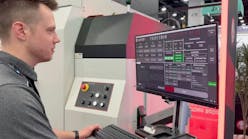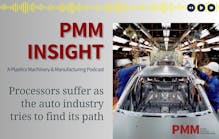Joe Campbell rebalances work demands
By Karen Hanna
On the day that he retires, Joe Campbell will join thousands of other baby boomers streaming out the doors. The daily tidal wave of retirements has been a recurring theme for him as he’s spent a career educating manufacturers on the benefits of deploying automation to offset some of the jobs current labor shortages have left open. In July 2023, he took a step toward his own retirement, transitioning from senior manager for strategic marketing and applications development for Universal Robots (UR) to part-time consultant. While not leaving automation behind entirely, he told PMM Senior Staff Reporter Karen Hanna he’s looking forward to having more time to spend with family and devote to hobbies and volunteering. During a Zoom interview, he spoke at his house in front of a statue of Bacchus, the Roman god of wine — a relic salvaged in the course of antique hunting.
What led you to automation?
Campbell: Boy, that was long ago, and far away. My second job out of college was in factory automation; I was selling PLCs. I enjoyed selling PLCs; I was actually quite good at it for that era. That got me into factory automation; shortly after that, I went into the robot business. I was completely fascinated by it. That coincided with a time of rampant inflation and quality problems; the U.S. automotive industry was in severe decline, losing market share to Japanese imports. Everybody rallied around robots as being the savior of American manufacturing. Turned out, it was a little bit more difficult than that, but that was the premise. I liked the excitement. I actually sold my first robot in 1979.
Forty-plus years later, is automation where you’d envisioned it would be?
Campbell: In some areas, we’re much further along, and some areas not so much. We’ve got robot providers, distributors and systems integrators, and everybody’s role is well-understood; [in] that era, there was no structure to the industry at all. Early on, I started a systems integration business, and, at that time, the biggest competitors we had were robot manufacturers because there was no integrator channel. If you were making robots, you were the one that was going to help deploy them. Now, obviously, we’re very refined in what the structure of the industry looks like. Today, most integrators specialize in one or two areas. If you’ve got somebody who works in plastic, they understand injection molding, they understand the secondary processes; that’s their world. That is one of the things that we’re focused on — the best integrator is somebody who really understands the process very well. Forty years ago, it was very common to try to have one company do everything. One of the companies that I worked for, we were pursuing large-scale automotive, spot welding, arc welding, precision assembly, vision inspection and everything in between; there was no specialization.
That’s one of the reasons why, at UR, at a trade show, we always have partners who build the demos and bring them into our booth. It’s because they’re the subject matter experts. I mean, I know a little bit about welding, but we’ve got partners that have lived in the welding world for 30 years.
From a technology standpoint, there’s a lot of technologies that were introduced in the early ’80s that are still around and are better, but not exponentially better. In the early ’80s, I was with a company that developed vision-guided robotics, vision-guided seam tracking for arc welding, vision-guided final assembly of automotive components. It was good, but it wasn’t perfect, and today we’re better, but maybe not quite perfect in some applications; it’s just taken a long time.
Are there still opportunities in automation that companies have not fully exploited?
Campbell: I think where we see that is in the small and medium enterprise companies. That was a segment that just has not been well-served by the whole industry for decades. The traditional technology was too complex; it’s too costly, took up a lot of floor space. UR was a pioneer. Because of our collaborative family of robots, we were able to penetrate the small and medium enterprises and actually deliver automation that was impossible in the past. That’s where we still see the low-hanging fruit. I think larger companies, what they’re doing with collaborative robots is learning a new way to use them, a new way to deploy automation. Years ago, it was the all-or-nothing syndrome — you either had to automate the entire process or the project [couldn’t be] justified. Because of the cost and overhead involved, you had to have projects of a certain complexity, to make [them] financially worthwhile. And today, I think we’ve just flipped that paradigm on its head. Today, we look for easy applications that can be quickly deployed [and] start generating ROI within weeks, instead of years.
Is there advice you’d give to those small and medium companies that aren’t fully taking advantage of automation?
Campbell: My challenge always is, open your eyes and let us come in and show you how the cobot works and what you can accomplish with it. Forty years ago, the products were completely complex; you really had to have specialized engineers to get anything done. But today, we’ve simplified the technology and made it so much easier to use. That’s the two-tier development [of robotics]: On the one hand, we’re making things easier to use [and] smarter. On the other hand, we have to build really complex programming to implement that. Successful OEMs are taking our cobot, and they’re building all this intelligence on the back end, which is very demanding, so it [is] really easy to use on the front end. We’ve got a great track record of taking smart people off the production line and teaching them the fundamentals of collaborative automation, and they wind up owning the process, and they do very well.
What changes have you seen in how companies deploy automation?
Campbell: There’s growth in the do-it-yourself market. You see [that in] small companies, where they’ve got a really good track record of taking one engineer or somebody off the line and having them deploy simple, straightforward applications. Those have been very successful. You’ll also see it in big companies [that have] large development teams in-house, and they tackle the more demanding jobs. We still have the case where, particularly where an integrator may be involved, the end customer wants to start with the most difficult project. And our counsel always is, “Please don’t start there. Start simple. Go work those projects. They’re lower-cost, lower-risk, quick to deploy, and they start generating return very quickly.”
Are there areas where automation hasn’t come as far as you would have thought?
Campbell: I don’t know that it’s fallen short; it maybe hasn’t gotten there yet. And it’s really because the market may not be as large as some of the other segments. Machine tending is the biggest application segment for not just us, but for the whole industry. It’s kind of where every robot company starts, by picking parts up and putting them down; so now, that is a very sophisticated process. It’s extremely well-understood; we see systems that get installed in one day, and they’re in production. But some of the other applications don’t have the volume behind them. With less volume, there’s less focus, and so maybe they haven’t evolved as quickly. The other thing that’s interesting, though, is we’re also starting to see applications outside of manufacturing. The one I find really interesting is in the construction field. Construction has the same labor challenges manufacturing does. They’re short on labor, they can’t hire people. Some of the jobs are perceived as just dull, dirty and dangerous. We’ve got a couple partners — one who has developed a drywall finishing system. There’s another one coming out of Europe, they’ve done a very sophisticated painting robot for construction. I think we’re going to see more of that kind of automation.
How do you see companies managing the balance of cobots vs. industrial robots?
Campbell: Collaborative technology is really remaking a lot of manufacturing, how we think about manufacturing and how we approach it. It’s helping small companies be far more competitive than they could be in the past. I think that bodes well for us — the industry and us as a society.
There are certain applications that you’re just not going to do with a cobot. One of the first tests is, if you make a couple million of a given product in a year and you need to do it at a very high speed, that’s probably not a good application for collaborative. I worked at a company, before I joined UR, we built gantry robots, and the heaviest-payload gantry robot we had was two-and-a-half tons. If you needed to pick up 5,000 pounds, we were the perfect fit; that’ll never be collaborative.
We can always go faster, and we can always go heavier. The real question is, at what point do the risk assessments tell you to use a traditional robot? ‘Cause that’s the key to the success of collaborative robots: You have to do a proper risk assessment to make sure you’re deploying them safely. It’s also about how the operator interacts. That’s why you can’t make a broad-brush statement about what’s safe, and what’s not safe. It does require at least the fundamentals of a risk assessment, which is nothing more than thinking about what could go wrong. How do I mitigate that risk of somebody getting hurt?
Have you seen any evolution in how companies approach safety issues?
Campbell: I push back quite often and say, “Look, it’s not just about the robot; you’ve got a whole plant full of machines, whatever your process is, and most of them are dangerous if you don’t pay attention.” And that’s really what it comes down to. I think companies are far more focused on safety than they were 40 years ago. They care more, they understand the risks, and they’re prepared to invest, to make sure that their employees are safe.
When you speak of cobots reshaping industry, what does that look like?
Campbell: Well, I think it takes a lot of different shapes. Let’s take a contract molder, they’re getting pressured to do more value-added processes. So, “don’t just mold the part, but I want you to clip the sprue off, and I want you to clear all the flashing off, and I want you to emboss it, and I want you to pack it, and I want you to do a subassembly. That’s what I want to buy from you, not just a molded part.” So, I think we’re seeing collaborative technology [helping] even small contract shops, who are the epitome of high-mix, low-volume [production]. If they can automate, that’s a huge win. And, so, I see that continuing. It’s not just the contract molders, but contract assembly shops and packaging and fabrication shops and welders, etc. The other place we see it is in the big companies, and they’re doing some really interesting things, leveraging cobots to do ergonomically unattractive tasks. [Multinational automotive manufacturing corporation] Stellantis [N.V.] deployed a really interesting cell in electric vehicle manufacturing at one of their Fiat plants. Basically, this large assembly is brought down over the chassis; the cobots actually drive nuts and screws on the underside, where it used to require an operator to squat down. The operators are still there, but they’re doing the processes that are much more accessible. That’s an example where they invested a tremendous amount of money to get some productivity gains, but more importantly, they did it to improve ergonomics.
What about robots for personal assistance, like on “The Jetsons”? Do you see that happening?
Campbell: Not from my perspective, but, if you look around, you can already start to see it happen. Look at the success of the Roomba. It’s spawned half a dozen competitors. We’ve got one and love it.
How might the evolution of artificial intelligence impact the strides in automation?
Campbell: I don’t think that’s anything in the near term. It’s possible it could make programming and development easier. But my personal view is it’s not ready for prime time; you can still fool a chatbot into making some pretty stupid mistakes. I think that’s the one thing a lot of people who entered the robot business didn’t understand. They didn’t understand the discipline of manufacturing, where 99 percent [accuracy] is a failure. A lot of people coming out of different technology fields enter the robot business and, in their fields, maybe 90 percent was OK … but not in manufacturing.
How important is automation to addressing current labor shortages?
Campbell: The whole job situation is really severe. We have such a gap in manufacturing labor, and that’s a perfect place to go attack that problem with automation. I think the latest numbers I saw were 694,000 open jobs in manufacturing. (According to the most recent numbers available from the U.S. Bureau of Labor Statistics, there were 676,000 openings at the end of April.) I think COVID convinced a lot of companies that offshoring all their manufacturing might not have been the best idea when they started to see the supply chain disruptions and they had just total lack of control. Many of these companies are reshoring, and that’s putting more pressure on the labor market. It’s going to be decades before it changes.
When I have discussions with CEOs, GMs or plant managers, the point I try to drive home is this is not an unemployment problem. It’s a demographic problem. And it’s going to take a long time to fix. The baby boomers, we’re retiring at the rate of about 10,000 a day, and that’s going to continue for years. And, in the manufacturing sector, we’re just not doing a good job attracting millennials, Gen Xers and Gen Zs. That’s going to take a long time to fix. There’s going to be continued pressure on the manufacturing job market for decades ahead.
What do you think companies should do?
Campbell: Companies are starting to understand that one of the ways to attract the younger generations is to pay attention and listen. For the younger generations, it’s on them to ask [questions]; they’ve got great ideas. You’ve got to listen to people and give them respect and runway to learn about the manufacturing world, and we’re seeing companies do that.
You can talk the talk, but you have to walk the walk. I see a lot of companies build cross-functional teams to deploy automation. One of the things we love to do is bring a robot into a plant and get people from the manufacturing floor to learn about it, and to work with it, just understand the fundamentals, and that in itself goes a long way. Another way we have — people are copying it, but for years, it was totally unique — is an online training academy. Right now, just under 200,000 people have been trained. [It] used to be the way you got trained on a robot is the shop manager would decide who was going to get trained, and they would send those people to the manufacturer’s facility for a week, and they would sit in a training class and get trained, at tremendous expense. Now, you can get the fundamentals of operating and programming a UR cobot in about two hours. We’ll see shop owners and managers say, “Take an hour, and spend some time on the academy. I’ll give you time to learn.” That goes a long way toward signaling to people that they’re valued.
How does automation help companies make their case?
Campbell: One of the best examples I’ve seen in this is Caterpillar … which built a job recruitment campaign around their use of cobots in their manufacturing operations, in arc welding and in machine tending. And their message basically was, “You should come work here because we’ve got all this cool stuff. It’s not the dark and dirty weld shop of the past. This is really interesting technology, look what we’re doing with it.” For a company of that size and scale to build a campaign to hire people around that, I thought that was really interesting. I say manufacturing likes cobots, and apparently human resources does, too.
[Automation] lets companies move their talented people into higher-value positions. I think welding is a great example. Skilled welders like to work on complex weldments that really test them. They don’t like to do production work. It’s repetitive work. It’s not particularly interesting or challenging. So, the smart weld shops are automating the low-end activities, making the repetitive parts, brackets and small subassemblies. They’re moving their skilled welders up to the bigger weldments, which is what interests them. And frankly, it’s also more profitable for the shop. The more of that we’re able to do, as a manufacturing community, the easier it is to attract people.
How does automation change the kinds of skills employees need to be able to contribute to plants?
Campbell: If you look at all the activity in the two-year schools and vocational technical schools, they’re really embracing the new technology. We’re starting to see some really interesting partnerships. The one example I like — because it’s close to my home and I know some of the people involved — [involves the] ThyssenKrupp Bilstein of America plant in Hamilton, Ohio. [It makes] high-performance shock absorbers and other parts for cars. They have a partnership with Butler Tech nearby; ThyssenKrupp gives the school a cobot, and the kids form a team and figure out how they can deploy it and where they can use it. It’s been wildly successful. ThyssenKrupp gets really skilled workers they know; they’ve worked with them over the course of a year, and the kids get this tremendous hands-on experience in the factory.
You recalled a perception that automation could bring American manufacturing back. And now we’ve come full circle, talking about reshoring of jobs. What is your outlook for American manufacturing?
Campbell: I think it’s going to be stronger than ever, and I think automation is at the core of it. There’s no place in the world where automation isn’t a key building block for society. The best example is, what country has the largest available workforce? China. What country actually consumes more robots than anybody else in the world? China. So, robot technology, whether it’s traditional or collaborative, like Universal makes, it’s a required building block for competitive manufacturing, and I think that puts us in a good position.
What are your plans for your retirement?
Campbell: Right now, I’m still working full time and, when I do retire, I’m going to keep consulting. I’ll support UR with certain projects and functions, and then a lot of partners in the UR network who would like to up their marketing game, and I can certainly help with that.
I’ve got plenty of interests, so I don’t think I’ll be bored.
My wife is an antiques dealer. She’ll buy old furniture, and I’ll do the refinishing. My daughter works for a nonprofit, and she’s recruiting me to come help her; of course, she says, “I can’t pay you, but really would like your help.” It’s called Metro Food Rescue. [It is] in the business of collecting and distributing surplus food to needy organizations. Their model is to collect food from commercial food manufacturers and distributors, everything from grocery stores to big-box retail, and take it out to organizations serving local needs. What I find so interesting is it’s a big logistics problem because on any given day, they don’t know what they’re going to get. She’s got 40 places where she can pick food up and 40 places where she can drop food off, and it’s her job to optimize what she gets [and] where it goes. It’s a problem that I think we all kind of knew it was there, but I had no idea how big it was, and her nonprofit, they’re a very important player.
Your LinkedIn profile indicates you’re also involved with the Community House in Birmingham, Mich. What’s that?
Campbell: That’s a different nonprofit. The CEO and president is a good friend. I do a small amount of help there; I’m going to probably step that up. It’s basically the host for a large number of community services, including childcare, daycare, adult education, yoga classes. They’ve got this great facility, and there’s always something going on.
What do you think your legacy will be?
Campbell: I hope people think of me as a lifelong learner, someone with the curiosity to explore new topics and technologies and take on new assignments, and, of course, the ability to learn quickly and communicate complex topics to engineers, managers, CEOs and teammates alike.
Karen Hanna, senior staff reporter
NAME: Joe Campbell, senior manager for strategic marketing and applications development for Universal Robots (UR), Novi, Mich.
AGE: 70
YEARS IN THE INDUSTRY: 45
EDUCATION: Bachelor of Arts, marketing, 1976, University of Cincinnati
Karen Hanna | Senior Staff Reporter
Senior Staff Reporter Karen Hanna covers injection molding, molds and tooling, processors, workforce and other topics, and writes features including In Other Words and Problem Solved for Plastics Machinery & Manufacturing, Plastics Recycling and The Journal of Blow Molding. She has more than 15 years of experience in daily and magazine journalism.
Request More Information






